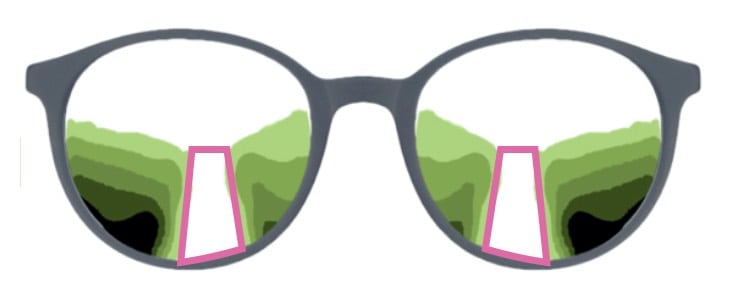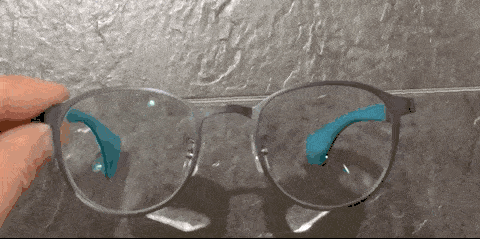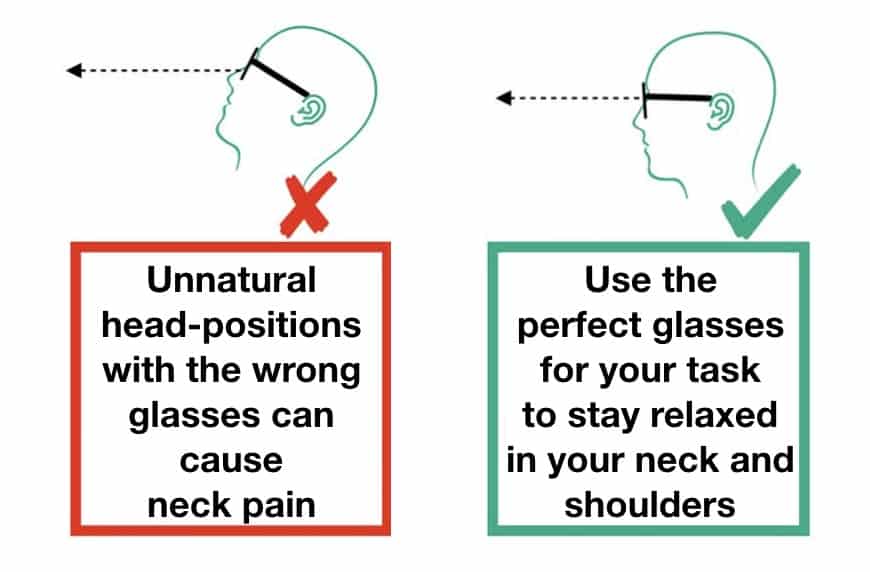In this article, we will discuss the disadvantages that may come along with progressive lenses. Body positions, prices, the field of view may be changed. Read on for more information.
1. You Still Need Separate Reading Glasses
If you love to read for a few hours or if you just want a comfortable solution for near range work you probably will need a second or a third pair of glasses. Think about it. In most cases, people are looking at distances somewhere in the room. One important distance is the PC Screen maybe a calendar on the wall. If they are not working they are staring at their phones and when they arrive at the home they switch to the TV to ease their minds a little bit.
Most people are just switching screens. All the described distances are found in the near range. Depending on the reading power you may be able to see sharp in the lower third of your progressive glasses. If you look at the picture below you can only use the area in the pink marked part to see clearly in the room. The green areas are blurry and the upper white space is made for distance vision.

Compare this space to reading glasses and you will realize with dedicated reading glasses the whole area for your lenses would be perfect for reading. That is why people tend to have more than just one pair of glasses to get the most comfort out of their glasses.
2. Straight Lines May Appear Bent
Yeah, I know that sounds scary but in the first few days especially when you wear progressive lenses for the first time you may experience this effect. It can appear because of the transition to reading power. In single vision lenses, this effect can also appear. But with the different zones in progressives, it is more likely.
If you wear your progressive glasses consistently this disadvantage will disappear. Not because of the optics in the lens but because your head is getting used to the lenses. After a while, people experience straight lines again. Only when people try to concentrate on this effect, they can see it again. This while can take just a few days for some people, or a few weeks for others.

3. Blurry Stairs and Falls in the Elderly with Progressive Glasses
If you already experienced falls I highly recommend you substitute your progressive glasses with single vision glasses made for the distance. The reason was described in point disadvantage number two in which we talked about straight lines appearing bent. In addition to the distortion, stairs are blurry because of the position of the reading area in the lens.
If you look down you can see clearly in the reading range. But not in the distance to the bottom. The combination of the blurriness and the distortion can lead to a higher risk for falls if you are an active person. This was examined by Haran et. al
This should be definitely considered during the consultation of progressive lenses. If you are fit and you did not experience falls you are totally fine with using your progressive lenses in outdoor activities or in places where you do not know every bump in the road. But if you already experienced falls directly order a pair of single vision glasses for the distance in addition to your progressive glasses.
4. When You Buy Progressive Glasses You Won’T Get the Possibility to Actually Test What You Order Before It Is Manufactured
Some people will speak against this disadvantage but trial frames with progressive lenses do not consider all the measurements that can make up for an optimal experience. And until now no simulation on an iPad, VR Glasses or augmented reality simulations convinced me to give my customers a realistic visual expectation before they have it on their nose.
Progressive lenses are simply a complex topic. And if the lens gets customize to your needs you just can not test it with all its disadvantages and advantages except for when it is made for you. Most people are not used to those buying experiences.

5. It Is Often Not Transparent What You Get and What the Progressive Lens Can Do
In the consultation process, it should be measured first to see which of the parameters of the progressive lens need to be tweaked to get the most comfort out of the lenses. I mean how far are your eyes apart. Do you have some binocular issues? Are you using a PC or a Laptop more? I could go on and on and for every answer, you can give me you can tweak the lenses or you need to switch the lens design. But the optician can´t know until he measured and asked everything he needs to understand your visual needs.
But what happens often is customers get in a shop and they get told this is the best lens design. Even before something was measured. How can the optician know? An easy list would be great to visualize what can be done and what needs to be done. For example, you can get one model of progressive lenses like the E Design from Essilor in a customized version if you ordered the 360 feature with it or you can get in a more standardized version.
That can make a big difference if you need this. And it can make absolutely no difference at all if you don´t need the customization. And as much you do not know about the products it is hard to tell if what you hear from the other end can benefit you. Because both of the described models are “Premium Progressive Lenses” But that term has no specifics. It actually tells you nothing.
6. One Big Disadvantage Is the Blurry Vision in the Periphery
When you drive and you are about to switch lanes and wanted to have a quick look back you might experience excessive blur. You are looking directly through a blurry area that exists in EVERY progressive lens design. Of course, you can see the dashboard clearer but those extreme eye movements are seldom a pleasure for you while wearing progressive lenses.
At the moment all progressive lenses have this blurriness inside of them. But that should just happen in the described situation. When the glasses are fitted well you will experience a very wide field of view in the distance. As you move down with your eyes you will always have blurry vision in the periphery. That is also totally fine if you read your mobile or tablet in most cases. For longer reading sessions single-vision reading glasses or PC glasses are the way to go.

7. Difficulties May Arise If You Have Issues in Your Neck / Unnatural Positions
Of course, people with neck issues will also get presbyopia and will have a need for progressive lenses. But you should take this statement with caution. If you are severely limited in moving your neck up and down or in the rotation it might be a good idea to stay away from progressive glasses. In single vision lenses or with contact lenses you can compensate for the limited movement of your neck and head with eye movements.
If you are working in a close-range environment and you need to position yourself every time new as you want to have a closer look at a paper on your desk you will not be satisfied. In those cases, single vision lenses or Computer glasses should be considered because they allow for a lot more eye movements.
But please consider that I mentioned severely limited movement abilities in the neck and head and shoulders can not go with progressive lenses. In most cases when you hear about neck issues from people with their progressive lenses they are not using it right. Those glasses are simply not made to be worn for long hours of PC work. They are adjusted in a way to let you see sharp in the distance during a natural head and neck position. And the PC is not far away from you it is in the near range.
What happens is your body will compensate for the missing reading power in the upper part of the lens. Your chin rises and you force yourself in an unnatural position to look through a lower area in the lens. Over a few hours, over a course of weeks and months, you spend a lot of time in that wrong position. This is how neck and shoulder problems can be developed over time.

8. It Takes More Time to Get Used to Progressive Glasses
The time to get used to the lenses can vary a lot. It depends on how high your prescription is, the needed reading power, and differences in your left and right eye. There is a slight learning curve to get used to the positions where you can read. Which is totally normal. A more complex product usually requires more time to get used to. You may ask yourself:
What happens when i do not get used to progressive glasses?
A typical question nearly every customer asks
If you do not get used to this particular model there is an unbelievable variety of models of progressive lenses you could switch to. And most of them offer you a satisfaction guarantee. If you are not satisfied you will get your money back. So easy.
9. You Can’t Wear Them in Every Position
When you are used to single vision lenses and you get your first PAL (progressive lenses) situations in which you lay down and get relaxed can be annoying. The reason is if you lean back, you tend to look through an area that is made for reading. It is sharp in the near range but if you want to watch TV the screen is too far away. You need to sit upright mostly to see the TV clearly.
In that situation, you can get an additional pair of single vision lenses to get the best vision out of your vision. People that lean way back in the car also will be reminded of their progressive lenses to sit more upright. Because the street will be just blurry as you lean back.

10. Lens Design Changes over Time
As you age over time you will need stronger progressive glasses. That means you get a new pair of lenses but if they are stronger than your last ones peripheral vision will be a little bit more restricted. This process will slow down as you reach the age of approximately 65. Because then your eyes will not be able to accommodate to the near range distance what so ever. In this case, the progressive lens will do the entire job and let you focus in the near range.
This is one of the reasons why not all progressive lenses are created equal. And as you can imagine. The more your peripheral vision is restricted the harder is the time for you to get used to the lenses. Especially if you start later in life with progressive lenses. You will have a smoother transition if you start earlier.
11. You Can Only Use Certain Frame Sizes with Progressive Glasses
I hear this all the time but in reality, you have a lot of options. The selection of frames is especially big now because a lot of styles are quite big. But you could go smaller also. Though my general recommendation to get slightly bigger frames is often better for you as a wearer. You just get more sharp areas out of the lens.
Even if you want to get a smaller frame you can get lenses that only need a minimum fitting height of 12-13mm. That is a really short lens. And in most frames, they can be fitted in.

12. It Is Really Easy to Mess up the Centration
That point is definitely the work of your optician. But if there is a lack of understanding of how the centration devices work you will get a messed up progressive lens. It happens more often than you might think. I have preferences for using video and foto centration technology which is great but far from being perfect. Just think about it. A lot of those devices are hidden behind a mirror. You as a customer are looking in a mirror and what happens you push your chest up stand a little bit more upright. And what happens.
You just changed the height of the area where you want to read. Everyone has their unique daily comfy body positions if you change them your progressive lenses will not be as comfy for you compared to as you just have stayed in your natural position.
13. Experience Dizziness While Using Progressive Glasses
When you are not used to your new progressive lenses dizziness can occur. It does not have to be that way but it can. The reason is the side-effects that could bring you this experience. These effects cause another motion of the picture you see from the environment in the upper and lower areas of your lenses.
Of course, you can think about it but I guess the short clip will clear up this short topic. The correct description for this is prismatic effects. Every lens has them. But the higher the transition has to be from the lens power the easier they are to experience.
If dizziness is a problem for you. The solution might be to lower the Add value by just about 0,25 or if you still can handle reading in a comfortable way even 0,5D. What will happen is you lose a little bit of the ability to read things in a close range BUT you will gain more room for eye movements, the prismatic side effects are smaller and blurriness of the bottom will be improved.
14. Progressive Glasses Are More Expensive
Depending on what quality or model of lenses you choose you can have a price bump from 100 $ to several hundred dollars. It depends on what you wear now and what you want/needs in your new lenses.
15. Progressive Glasses Are Perfect for Nothing
Progressive glasses are far from perfect. But frankly spoken they are better than ever and the tech we have right now will not change things radically if electro-sensitive materials are not going to come into play. If nothing changes the lens surface we will go on in incremental steps to improve progressive glasses. It is true that they are not specifically perfect for one thing they can still enhance 95 % of your daily activities.
A short look on your phone or your watch. That is easy. No need to change glasses. That is what progressive glasses are made for. And they enhance so many daily visual routines. That is why these lenses are my absolute favorites.
I gave you a lot of disadvantages here in this article. Still, the advantages outweigh the disadvantages. And one big factor why so many people are buying these glasses is time and convenience. Nearly nobody wants to change glasses all the time.
Usually, people just want to look down and want to be able to see clearly. And that is exactly what progressives do. Of course, you have less peripheral vision while reading and it takes some time until you are one unity with your lenses and the but that was the case for millions of people before you. Pushing the boundaries and to get you the very best vision possible is my mission. And it was great to write again about my favorite topic.
I wish you a great day.

